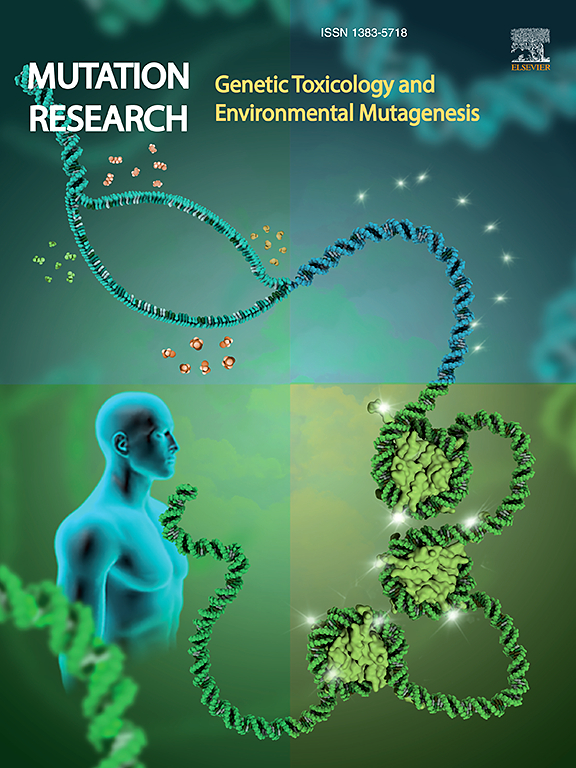Frequency of γ-H2AX foci, micronucleus formation, and radiation dose to the blood lymphocytes in pediatric and adult participants underwent computed tomography imaging
IF 2.5
4区 医学
Q3 BIOTECHNOLOGY & APPLIED MICROBIOLOGY
Mutation research. Genetic toxicology and environmental mutagenesis
Pub Date : 2025-09-18
DOI:10.1016/j.mrgentox.2025.503897
引用次数: 0
Abstract
Computed tomography (CT) is a widely used diagnostic imaging modality that contributes significantly to human healthcare. Despite the advantage, its extensive use increased concerns due to receiving radiation doses to pediatric patient's over adults during CT imaging. We evaluated the biological effects (Gamma-H2AX (γ-H2AX) foci and micronucleus (MN) formation) of low-dose X-radiation on the peripheral blood lymphocytes of pediatric (n = 45) and adult (n = 38) participants before and after CT imaging. Participant-specific organ doses were calculated using VirtualDose™CT software, weighted to the corresponding organ's blood volume, summed to derive the blood dose, and then related to induced DNA damage. A significant (p < 0.001) increase in γ-H2AX foci and MN frequencies was observed in both pediatric and adult groups after CT imaging. While the mean effective dose (ED) in pediatric and adult (16.21 ± 11.33 mSv and 31.30 ± 16.25 mSv) participants were significantly different (p < 0.001), the mean blood doses did not differ (9.83 ± 6.34 mGy and 12.82 ± 5.96 mGy) (p > 0.05), respectively. A weak correlation was observed between the induced DNA damage to that of ED and blood dose. The results suggest that damage to blood lymphocytes after CT imaging was observed by an increased γ-H2AX foci result of DNA double-strand breaks. The increase in MN frequency suggests activation of DNA repair, thereby contributing to minimal damage, although they are unstable. Therefore, it is necessary to follow up on the pediatric participants to look for stable aberrations to better relate DNA damage to exposure and long-term health effects, if any.
对儿童和成人参与者的γ-H2AX病灶频率、微核形成和对血液淋巴细胞的辐射剂量进行计算机断层成像
计算机断层扫描(CT)是一种广泛使用的诊断成像方式,对人类医疗保健有重要贡献。尽管有优势,但由于在CT成像时儿科患者接受的辐射剂量高于成人,因此其广泛使用增加了人们的担忧。我们评估了低剂量x射线对儿童(n = 45)和成人(n = 38)受试者外周血淋巴细胞的生物学效应(γ-H2AX (γ-H2AX)病灶和微核(MN)形成)。使用VirtualDose™CT软件计算参与者特定器官剂量,加权到相应器官的血容量,求和得出血剂量,然后与诱导的DNA损伤相关。在CT成像后,儿童组和成人组的γ-H2AX病灶和MN频率显著增加(p <; 0.001)。平均有效剂量(ED)在小儿和成人(16.21 ± 11.33毫西弗和31.30 ± 16.25 mSv)参与者明显不同(p & lt; 0.001),平均血剂量没有差别(9.83 ±6.34 mGy和12.82±5.96 mGy) (p 祝辞 0.05),分别。ED诱导的DNA损伤与血药剂量之间存在较弱的相关性。结果表明,DNA双链断裂的γ-H2AX灶增高是CT显像后淋巴细胞损伤的主要表现。MN频率的增加表明DNA修复的激活,从而导致最小的损伤,尽管它们是不稳定的。因此,有必要对儿童参与者进行随访,寻找稳定的畸变,以便更好地将DNA损伤与暴露和长期健康影响(如果有的话)联系起来。
本文章由计算机程序翻译,如有差异,请以英文原文为准。
求助全文
约1分钟内获得全文
求助全文
来源期刊
CiteScore
3.80
自引率
5.30%
发文量
84
审稿时长
105 days
期刊介绍:
Mutation Research - Genetic Toxicology and Environmental Mutagenesis (MRGTEM) publishes papers advancing knowledge in the field of genetic toxicology. Papers are welcomed in the following areas:
New developments in genotoxicity testing of chemical agents (e.g. improvements in methodology of assay systems and interpretation of results).
Alternatives to and refinement of the use of animals in genotoxicity testing.
Nano-genotoxicology, the study of genotoxicity hazards and risks related to novel man-made nanomaterials.
Studies of epigenetic changes in relation to genotoxic effects.
The use of structure-activity relationships in predicting genotoxic effects.
The isolation and chemical characterization of novel environmental mutagens.
The measurement of genotoxic effects in human populations, when accompanied by quantitative measurements of environmental or occupational exposures.
The application of novel technologies for assessing the hazard and risks associated with genotoxic substances (e.g. OMICS or other high-throughput approaches to genotoxicity testing).
MRGTEM is now accepting submissions for a new section of the journal: Current Topics in Genotoxicity Testing, that will be dedicated to the discussion of current issues relating to design, interpretation and strategic use of genotoxicity tests. This section is envisaged to include discussions relating to the development of new international testing guidelines, but also to wider topics in the field. The evaluation of contrasting or opposing viewpoints is welcomed as long as the presentation is in accordance with the journal''s aims, scope, and policies.

 求助内容:
求助内容: 应助结果提醒方式:
应助结果提醒方式:


